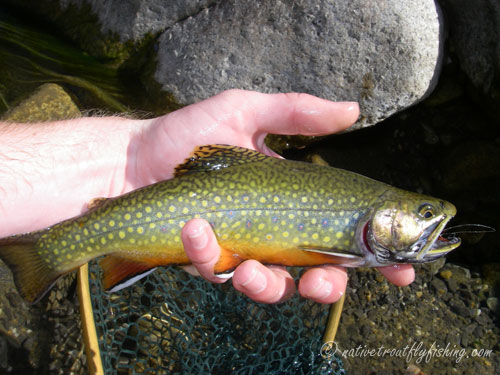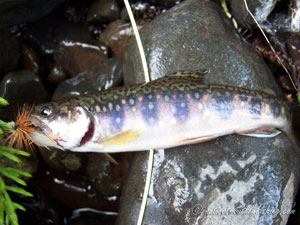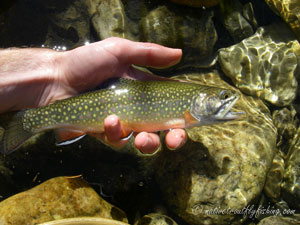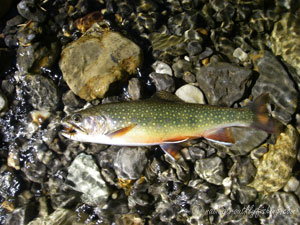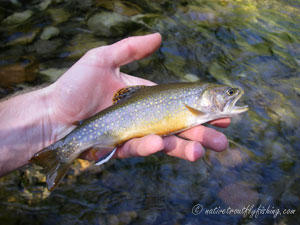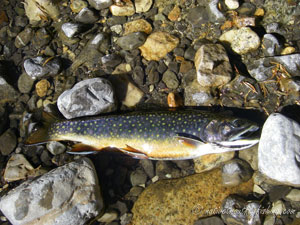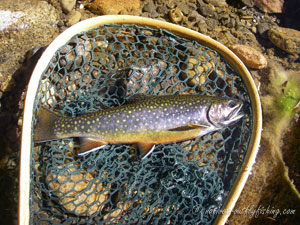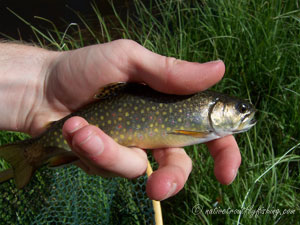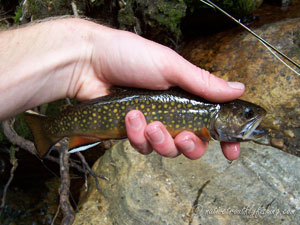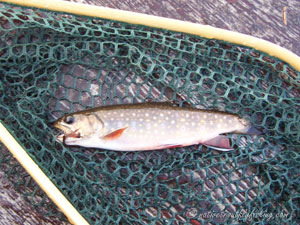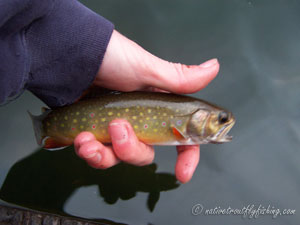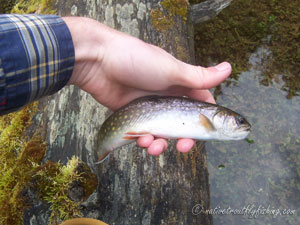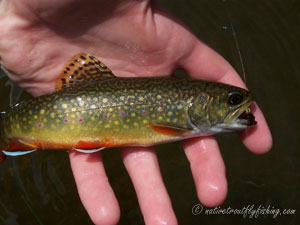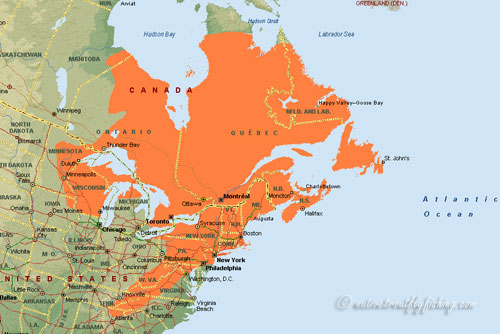Brook Trout
Salvelinus fontinalis
A stream resident Brook Trout from outside its native range in the Wyoming Rockies.
Introduction
While Brook Trout (also called Speckled Trout or Brookies) are native to the eastern United States they have also been extensively stocked in many western waters and have gained a firm foothold across the region. The native range of Brook Trout extends as far west as Minnesota and east to the coastal streams of the Atlantic and from Hudson Bay in the north to the mountains of Georgia in the south. Historically there were two subspecies of Brook Trout in North America, the Silver Trout (Salvelinus fontinalis agassizi) and the Aurora Trout (Salvelinus fontinalis timagamiensis). However, the Silver Trout have since gone extinct due to the introduction of nonnatives and the Aurora Trout has only very narrowly escaped extinction as well. Recent research has also shown that Brook Trout in the southern part of their range are differentiated enough from those in the north to warrant a possible future subspecies level division.
Life History Information
Out of all of the North American species of char, Brook Trout are the most "trout-like" in their behavior and habits. As Brook Trout have a large native range they display all four life histories common to other salmonids (stream resident, fluvial, lacustrine and anadromous). The most common of these life history forms their native range are stream resident and fluvial populations.
Stream dwelling Brook Trout are found primarily in smaller headwater streams in the southern part of their range. Spawning typically takes place anywhere from late September through November, with fry emerging in during the spring. Brook Trout are opportunistic feeders and feed largely on aquatic and terrestrial insects. Brook Char are generally a short-lived species, with wild individuals seldom attaining 5 years of age. However, in colder lakes and larger rivers of northern Canada Brookies may live to be nine or ten years old and reach sizes of ten pounds (Behnke 2002). Sexual maturity is usually reached at age three, but some individuals may mature at age two (Naiman et al. 1987). Studies have shown that when Rainbow Trout and Brown Trout are present in the same stream, brook trout will tend to shift their diet more towards the nymph stages of aquatic insects (Behnke 2002).
There are numerous lakes across the native range of the Brook Trout and as such lacustrine populations are rather common. These lacustrine Brook Trout spawn around the same time as stream populations and while inlet or outlet streams may be used for spawning, they also have the ability to spawn in the shoal areas of the lakes. Spawning occurs during the fall over a period of about 2 months, and is typically triggered by a drop in water temperatures (to below 52 degrees F) and an increase in precipitation (Blanchfield and Ridgway 1997). Females select areas upwelling for their redds, to ensure that the eggs receive enough oxygen. In some scenarios, especially outside their native range, populations often do too well and become overpopulated, resulting in a lake full of small 6" to 8" brook trout. The diet of these fish is similar to that of stream dwelling fish, with invertebrates making up the bulk of their diet, however once the fish get large enough they will also opportunistically feed on smaller forage fish as well. The Great Lakes are home to a unique lacustrine form of brook trout known as coasters. These coasters generally seek out protected areas of the lakes, with a variety of structure and cover, especially areas with sand or coarse gravel (Gorman et al. 2008). A study looking at the movements of coaster Brook Trout in Nipigon Bay on Lake Superior showed that Brook Trout spent 92% of their time in shallow nearshore areas. During July and August they are found in the steeper portions of the shoreline and make migrations between deep water during the day and shallow water at night (Mucha and Mackereth 2008). In late summer the coasters move into tributaries to the lake and generally spawn by early October, before returning to the lake in mid-October (Mucha and Mackereth 2008).
Anadromous populations of Brook Trout are most common throughout the northern part of the species range, but extend as far south as New York. Today the prominence of this life history for has been greatly reduced across much of New England, although some remnant populations are thought to still occur as far south as Long Island. Many of the remaining populations, especially in Canada, co-occur with Atlantic Salmon. In these populations juvenile Brook Trout feed most heavily on terrestrial insects (50-80%) while juvenile Atlantic Salmon feed mostly on aquatic insects (60-90%), especially mayflies (Mookerji et al. 2004). Brook trout typically smolt during May and June, at an age of one to three (Naiman et al. 1987). Upon entering marine watershed, smolts spend a significant amount of time in the estuary feeding on aquatic insects. However, by summer they typically move out of the estuaries and shift their diet to marine prey items including amphipods and mysids (Morinville and Rasussen 2006). Anadromous Brook Trout show a tendency to remain in shallow (8 feet deep or less) nearshore waters and rarely venture out of protected bays (Curry et al. 2006). They typically return to freshwater as early as late July and continuing through September, with spawning occurring during October and November (Curry et al. 2006). Sea-run Brook Trout generally overwinter in freshwater and utilize both lakes and streams. During subsequent years in marine waters, Brook Trout feed on both crustaceans and fish, with a greater shift to fish once the reach a size of 10” or more (Morinville and Rasmussen 2006). Studies done in the 1940’s indicate that Brook Trout in estuaries feed heavily on young eels and saltwater isopods, while amphipods, nereid worms, and freshwater aquatic insects constituted the remainder of the diet. In comparison those in salt water were much more piscivorous and consumed at least seven species of marine fishes (White 1940, White 1942).
Status
Due to their favor with sports anglers, Brook Trout today are much more widespread then they historically were. Brookies have been widely stocked in lakes and streams of the west and are firmly established in many of these waters, where that often times have negative impacts on the native salmonids. Within their own native range brook trout have problems of their own with introduced species. While Brook Trout are not currently listed under the Endanger Species act, like other native salmonids, Brook Trout have seen declines across their native range. A variety of factors including over-fishing, non-native species, habitat destruction and acid rain have all played roles in the loss of populations of these fish. A study conducted on over 70% of the Brook Trout's native range in the United States found that 28% of populations have been extirpated and in another 35% of the populations the available habitat had been compromised (Hudy et al. 2008). One of the Brook Trout's saving graces has been their ability to reproduce at a small size. Due to this, negative impacts on survival of certain age classes do not always impact the overall viability of the population and as such brook trout as a species are faring better than many other salmonids (Marschall and Crowder 1996). While non-native trout introductions have been problematic, pollution and habitat loss have also been a major cause of decline. Acid rain has been particularly problematic to some Brook Trout populations and may lead to lower fitness and survival or all out elimination of populations. MacAvoy and Bulger (1995) showed that streams with low pH (acidic) tended to have poor survival for Brook Trout, especially those in the embryo and fry stage. Other studies have shown that acidic conditions led to decreased growth and may lead to stunted populations (Marschall and Crowder 1996). Logging has been problematic, leading to increased flooding and warmer and lower summertime conditions.
Silver Trout - Salvelinus fontinalis agassizi
The Silver Trout provides an example on the effects of non-native and hatchery trout plantings on native Brook Trout populations. The silver trout were a unique subspecies of Brook Trout that lacked the vermications (wave like markings on their backs) and tended to be more slender and silvery than Brook Trout. These char were native to Dublin Pond in New Hampshire, where they had coexisted with a native population of Brook Trout that maintained their genetic integrity by spawning a couple of weeks earlier than the Brook Trout. However, as overfishing in the lake began to have an impact on the fishing, hatchery Brook Trout were stocked and these fish which had not co-evolved hybridized the Silver Trout into extinction.
Similar situations have occurred with hatchery Brown and Rainbow Trout replacing native Brook Trout populations by out-competing them for food and space. When Brown Trout are present, they will exclude Brook Trout from the best holding and resting areas (Fausch and White 1981). Brown Trout are also more predatory than Brook Trout and can significantly affect Brook Trout populations through predation on brook trout fry. Especially in the southern Appalachian Mountains a number of projects have been conducted to remove non-native fish species and restore Brook Trout to their native waters.
Description
Being a char, Brook Trout feature light spots against a darker background color. The back of these fish is a greenish-olive color and often transitions to a yellow-orange or crimson color on their lower half, a feature that is especially pronounced in spawning males. Anadromous and lacustrine Brook Trout are typically much more silvery in coloration until they approach spawning, at which point they begin to resemble other Brook Trout. A feature that sets Brook Trout apart from other North American trout and char is that they exhibit vermications, which are wavy pale yellow markings along their backs. The sides of Brookies are also have scattered with small red spots that are surrounded by light blue hallows that are scattered among larger yellow spots. The lower fins on Brook Trout are a reddish-orange color, with a white and black border.
Stream Resident Form
Click on images to view a larger picture
Contact
Feel free to contact me if you have any questions or comments
Native Trout Links
Truchas Mexicanas' - Native Trout of Mexico
Balkan Trout Restoration Group
Trout and Seasons of the Mountain Village - About Japanese Trout
Western Native Trout Challenge
California Heritage Trout Challenge
Fly Fishing Blogs
Dave B's Blog: Fly Fishing for Native Trout
The Search for Native Salmonids
Conservation Links
Western Native Trout Initiative
Fly Fishing Links
Fishing Art Links
Americanfishes.com - Joseph R. Tomelleri
